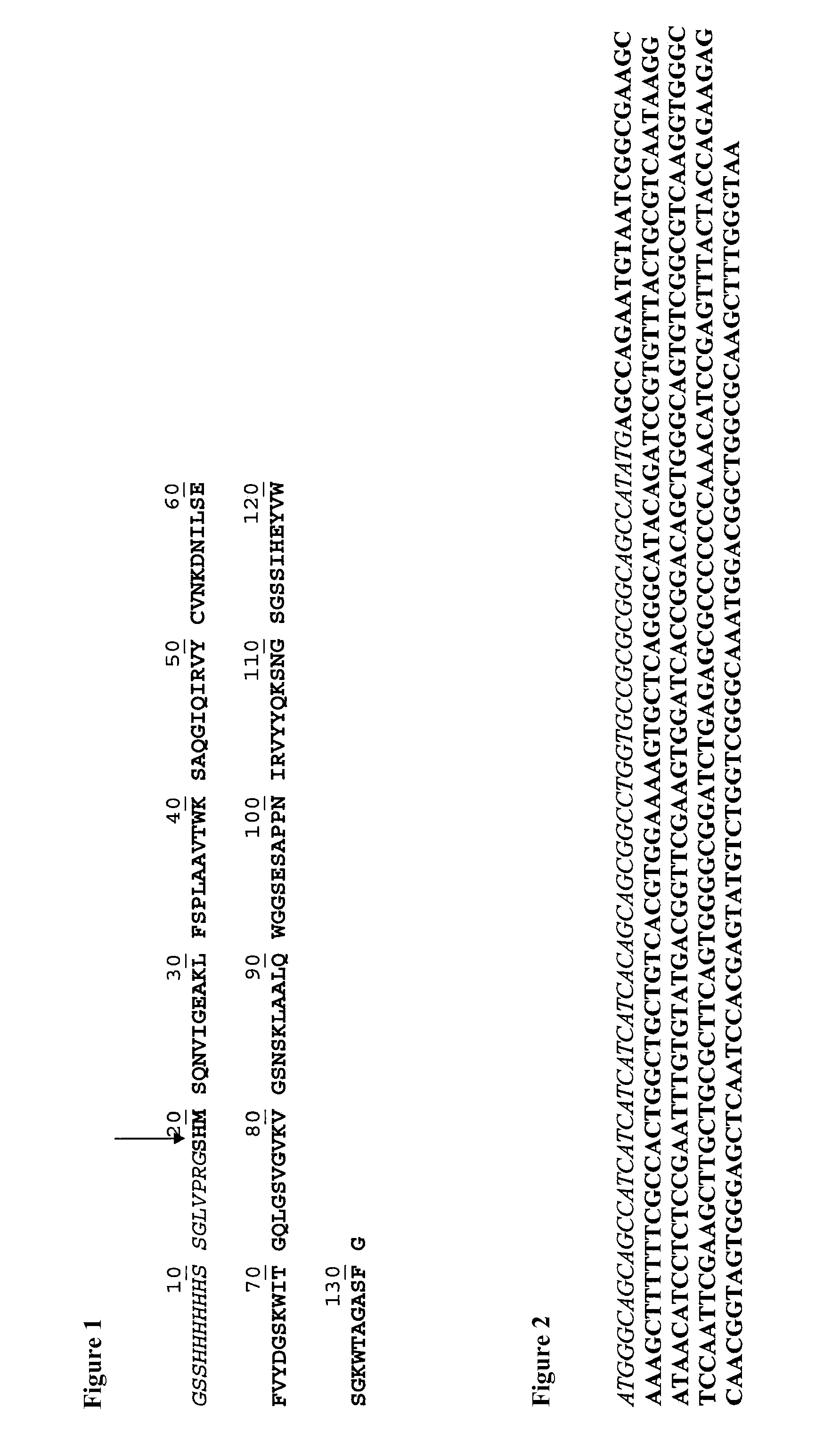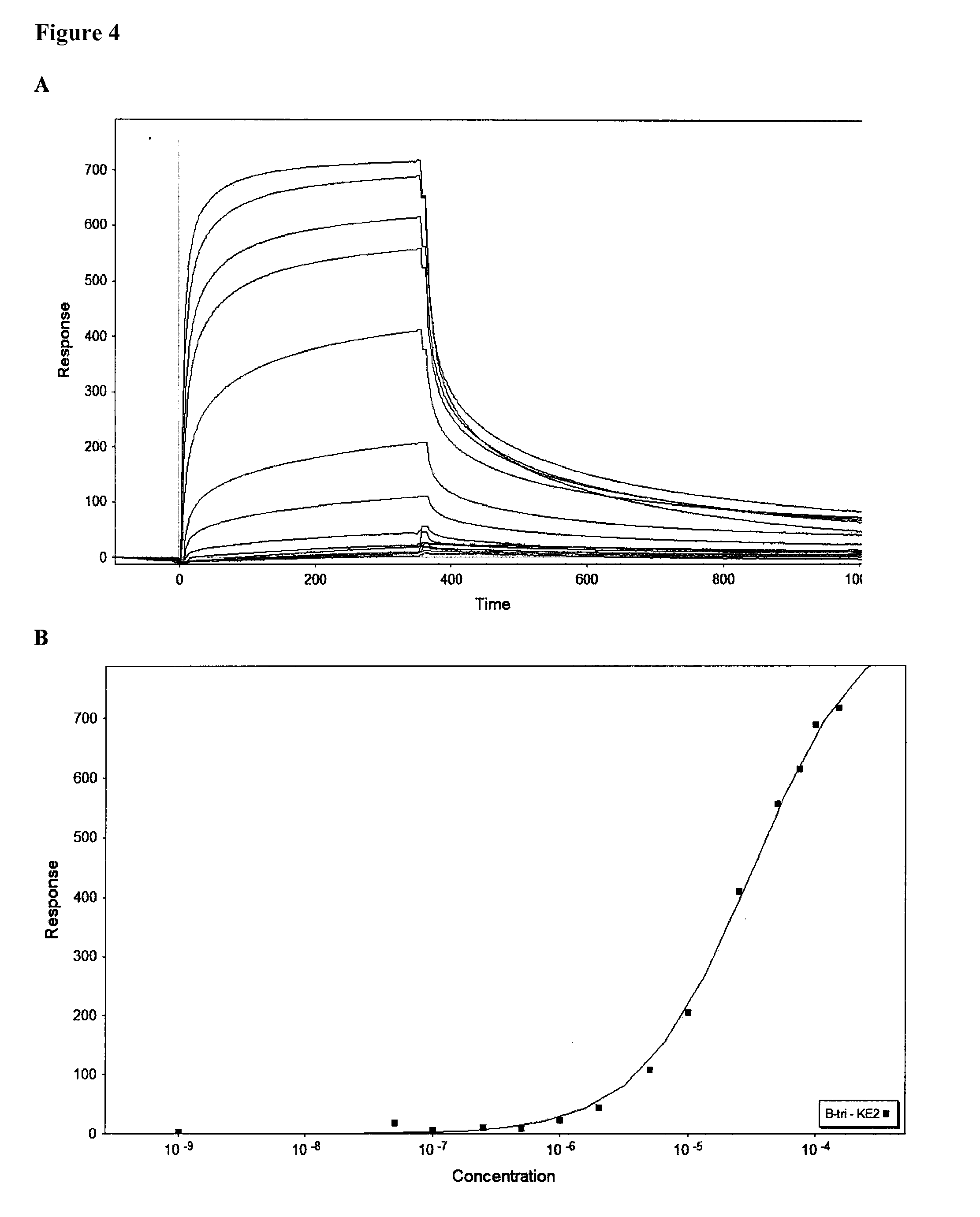Peptides and uses thereof
a technology of carbohydrate binding peptides and peptides, which is applied in the field of monovalent carbohydrate binding peptides and monovalent fucose binding peptides, can solve the problems of not working to produce monovalent binding peptides, methods that are not generally applicable to other lectins, and rarely obtain linear relationships between expressed antigen and amount of bound lectins, etc., to achieve the effect of enhancing the diagnostic range of assays
- Summary
- Abstract
- Description
- Claims
- Application Information
AI Technical Summary
Benefits of technology
Problems solved by technology
Method used
Image
Examples
example 1
Construction of Plasmid, Expression and Purification of a His-tagged form of a monovalent fucose-binding AAL fragment (Mono-F2, SEQ ID NO: 4).
[0073]A pET-28b-plasmid containing cDNA encoding full length His-tagged AAL was obtained as described (Olausson et al. 2008). A pET-28b-plasmid containing cDNA encoding Mono-F2 (SEQ ID NO: 4) was obtained by:[0074]1. Insertion of a NdeI restriction enzyme cleavage site at nucleotide position 150 in the AAL coding sequence.[0075]2. Insertion of a stop codon site at nucleotide position 480 in the AAL coding sequence to remove the 3′ segment of AAL corresponding to nucleotides 481-939.[0076]3. Restriction enzyme cleavage of the plasmid with NdeI to remove the 5′ segment of AAL corresponding to nucleotides 1-150.[0077]4. Ligation of the plasmid using T4 ligase.
[0078]The amino acid sequence of the His-tagged form of Mono-F2 (SEQ ID NO: 4) and its corresponding cDNA sequence are shown in FIG. 1 and FIG. 2. The cDNA sequence was confirmed by Sanger d...
example 2
In Contrast to Full Length raal Mono-F2 (SEQ ID NO: 4) does not Agglutinate Red Blood Cells Confirming its Monovalent Nature
[0083]The hemagglutination activity of full length rAAL and Mono-F2 (SEQ ID NO: 4) was determined by serial dilutions of the lectins in PBS and mixing with an equal volume (50μL) of 2% human type 0erythrocytes suspended in PBS. After incubation at room temperature for 1h the minimum lectin concentration that gave a positive reaction was determined. The minimal concentration of rAAL to produce hemagglutination was 2.5μg / ml (˜71 nM) whereas Mono-F2 (SEQ ID NO: 4) did not give hemagglutination even in concentrations up to 200 μg / ml (˜14000 nM).
example 3
Affinity Chromatography Shows High Affinity Binding of Mono-F2 (SEQ ID NO: 4) to Immobilized Fucose
[0084]Purified Mono-F2 (SEQ ID NO: 4) was analyzed on a 1 mL fucose-agarose column (Sigma-Aldrich, Stockholm, Sweden). The column was equilibrated with 20mL PBS. Mono-F2 (SEQ ID NO: 4) was added and the column was incubated for 20 minutes at 4° C. with gentle rocking. After incubation the column was washed with PBS until the absorbance at 280 nm had reached zero. Elution was performed with 4 mL of 0.15 M L-fucose in PBS, 4 mL of 1 M L-fucose in PBS, and lastly with glycine buffer pH 2.5. Fractions (1 mL) were collected with monitoring of absorbance at 280 nm. The fractions were further analysed by SDS-PAGE. The analysis showed that Mono-F2 could not be eluted with 0.15 M fucose. Very little was eluted with 1 M fucose. A low-pH buffer had to be used to get full elution of Mono-F2 (SEQ ID NO: 4) from the fucose-agarose column indicating high affinity binding to fucose.
PUM
| Property | Measurement | Unit |
|---|---|---|
| molecular weight | aaaaa | aaaaa |
| molecular weight | aaaaa | aaaaa |
| pH | aaaaa | aaaaa |
Abstract
Description
Claims
Application Information
 Login to View More
Login to View More - R&D
- Intellectual Property
- Life Sciences
- Materials
- Tech Scout
- Unparalleled Data Quality
- Higher Quality Content
- 60% Fewer Hallucinations
Browse by: Latest US Patents, China's latest patents, Technical Efficacy Thesaurus, Application Domain, Technology Topic, Popular Technical Reports.
© 2025 PatSnap. All rights reserved.Legal|Privacy policy|Modern Slavery Act Transparency Statement|Sitemap|About US| Contact US: help@patsnap.com



